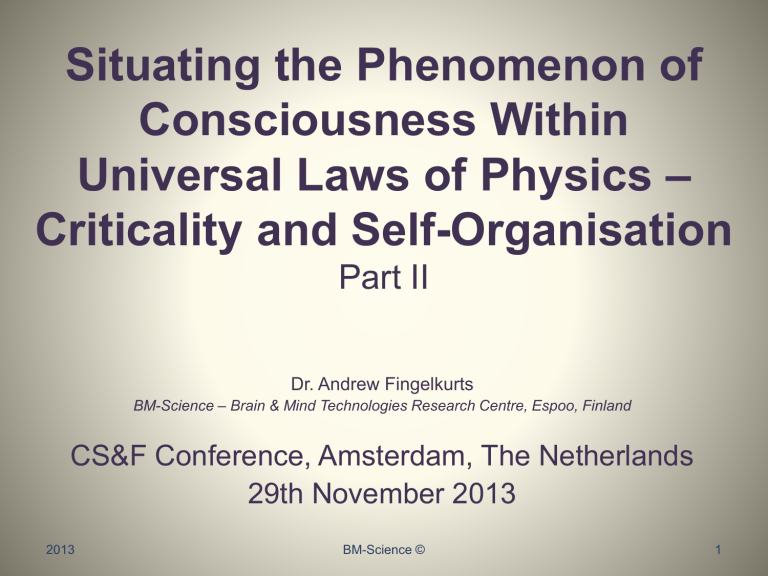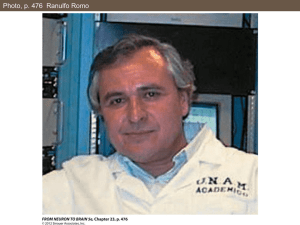criticality and self-organisation

Situating the Phenomenon of
Consciousness Within
Universal Laws of Physics –
Criticality and Self-Organisation
Part II
2013
Dr. Andrew Fingelkurts
BM-Science – Brain & Mind Technologies Research Centre, Espoo, Finland
CS&F Conference, Amsterdam, The Netherlands
29th November 2013
BMScience © 1
Studying brain operational architectonics (simple operations)
At the bottom of the OST level there is a high multiplicity of local extracellular fields.
Local EEG waves recorded from the scalp are the result of self-organized integrated excitatory and inhibitory post-synaptic potentials of neuronal membranes. Since they reflect extracellular currents caused by synchronized neural activity within the local brain volume, they are expressed within local
EEG signals in the form of quasi-stationary segments, each of which representing an envelope of amplitude modulation (so called a ‘‘common mode ’’/‘‘wave packet’’ or a ‘‘standing wave’’) in the neuronal mass under the recording electrodes.
The more neurons transiently synchronize their post-synaptic potentials the higher the amplitude of a common local field which is an indication of the collective behavior at an emergent mesoscopic scale – neuronal assembly formation.
Fingelkurts, Fingelkurts & Neves, 2009, 2010, 2013
BMScience © 2013 2
Studying brain operational architectonics (simple operations)
EEG quasi-stationary segments are equivalent to simple mental operations (phenomenal qualities, primary cognitive operations and emotions).
The transition from one segment to another then reflects the moment of abrupt switching from one neuronal assembly’s operation to another.
Physically one could interpret such transition as following:
(i) The previous quasi-stable period (reflecting an emergent field of the collective behavior of many neurons) was formed so that the neuronal assembly could perform an immediately present simple operation guided by either external stimulation or internal aim.
(ii) Over time conditions naturally change and there is energy flow into an open system (neuronal assembly). This leads to an increase in entropy and the process continues until it reaches a critical threshold.
(iii) At this critical threshold – RTP, the old system dissolves under the stress of entropic fluctuations through a sudden increase of entropy and abruptly reorganizes itself into a new system so as to offload entropy through negentropy and thus meet the new requirement(s) – execution of a new operation.
Fingelkurts, Fingelkurts & Neves, 2010, 2013
BMScience © 2013 3
Studying brain operational architectonics (simple operations)
In the physics literature RTPs are referred to as renewal (or critical) events; namely, the events that reset the memory of the system so that waiting times between two such events are all mutually independent, as proved by
Allegrini et al.
Allegrini et al., 2009
This latter property is in fact a mathematical definition of a well-known physical phenomenon of ‘‘intermittency’’ and is compatible with self-organized criticality in physical systems.
Recently, it has been documented that RTPs are indeed ‘‘crucial events’’ that correspond to phase-transition induced criticality and have power-law distributed inter-event times.
Allegrini et al., 2010; Paradisi et al., 2012
Beggs and Plenz propose to view such dynamics of local fields generated by neuronal assemblies as ‘‘neuronal avalanches’’ analogous to avalanches of physical systems characterized by Bak and coworkers. As recently proposed, neuronal avalanches are the signature of brain function near criticality at which the cortex optimally responds to inputs and maximizes its information capacity.
Beggs & Plenz, 2003; Bak, 1997; Chialvo & Bak, 1999; Plenz, 2012
Also, it has been documented that sequences of avalanches themselves are organized as avalanches. This suggests that there is no temporal or spatial scale, at which ongoing neuronal activity deviates from avalanche dynamics, and therefore we may expect similar behavior at the large-scale level of brain electrical field.
Here we come to the macro-level of OST organization of the brain.
BMScience © 2013 4
Studying brain operational architectonics (complex operations)
At the macro-level of OST organization, the brain OA is presented by self-organized and transitory spatio-temporal patterns formed by synchronized local fields that are generated by spatially dispersed local neuronal assemblies.
As it has been discussed above, individually each neuronal assembly presents only a partial aspect of the whole object / scene / thought / concept, while the wholeness of
‘‘perceived’’ or ‘‘imagined’’ is brought into existence by joint
(synchronized) operations of many functional and transient neuronal assemblies in the brain. Thus, complex mental operations are presented by synchronized simple operations.
Fingelkurts, Fingelkurts & Neves, 2013
2013 BMScience © 5
Studying brain operational architectonics (complex operations)
The constancy and continuous existence of each OM persist across a sequence of discrete and concatenated segments of stabilized (coupled) local EEG activities (indexed by SCs) that constitute each particular OM.
Conceptually, the continuity of any given OM exists as long as the set of neuronal assemblies located in different brain areas maintains synchronicity between their discrete operations.
The notion of OM’s operational space –time (OST) applies here.
Intuitively, OST of any given OM is the abstract (virtual) space and time which is ‘‘self-constructed’’ in the brain each time a particular
OM emerges.
BMScience © 2013 6
Studying brain operational architectonics (complex operations)
OMs are characterized by different order of recruitment of cortical areas: from any two to the whole cortex.
Thus, lower-level OMs (being themselves the result of synchronized operations produced by distributed transitive neuronal assemblies) can further combine diversely with one another, both, within the same, and across different temporal scales, to form a more abstract higher-level OM in a nested hierarchy, thus constituting a more integrated experience.
In such operational architecture, each of the complex OMs is not just a sum of simpler OMs, but rather a natural union of abstractions about simpler OMs.
Therefore, OMs have a rich combinatorial complexity and the ability to rapidly reconfigure themselves.
Fingelkurts, Fingelkurts & Neves, 2009, 2010, 2013
BMScience © 2013 7
Studying brain operational architectonics (complex operations)
Recent calculations have shown that power-law statistics do indeed govern the probability that a particular number of cortical areas is recruited into an OM
(defined as the temporal RTP coincidences among different EEG channels).
Allegrini et al., 2009
This ubiquitous dependency is characteristic for a fractal relation between different levels of resolution of the data, a property also called self-organized criticality.
Bak et al., 1987
It has been shown that OMs are driven by a renewal process with power index μ
≈ 2, which is in line with Beggs and Plenz’s avalanche dynamics of cortex activity, though in this case at the large-scale level of brain OA organization – synchronization of local fields generated by multiple neuronal assemblies .
Allegrini et al., 2009, 2010a,b
BMScience © 2013 8
Studying brain operational architectonics (dynamics)
According to OA theory, the metastable OMs at an OST level somehow
‘‘freeze’’, and
‘‘classify’’ the ever changing and multiform stream of our cognition and conscious experiences, whereas the succession of complex cognitive operations, phenomenal images or thoughts (the stream of phenomenological consciousness) is presented by the succession of discrete and relatively stable OMs, which are separated by rapid transitive processes (RTPs), i.e. abrupt changes of OMs.
Fingelkurts, Fingelkurts & Neves, 2010, 2013
2013 BMScience © 9
Studying brain operational architectonics (dynamics)
In terms of critical theory of physics and analogous to the formation of neuronal assemblies described above, within the RTP between two consequent OMs there is a brief period when the drastic and abrupt increase in degrees of freedom among participating neuronal assemblies is accompanied by a sudden increase in entropy, information and dimensionality, followed by a quick reduction in the degrees of freedom of neuronal assemblies and rapid decrease in entropy, information and dimensionality. The second phase of such RTP is indicative of the selforganization of a new presentational state expressed in the form of a new
OM within brain OST.
Fingelkurts, Fingelkurts & Neves, 2013
BMScience © 2013 10
Conclusion
Understanding human consciousness requires the description of the laws of the immediately underlying neural collective phenomena, the nested hierarchy of spatiotemporal patterns of 3D electromagnetic fields produced by neuronal assemblies.
Our analysis has shown that the structure, organization, dynamics, constitutive and causal relationships of such nested hierarchy of operational architectonics of brain activity are guided by the universal physical laws such as criticality, self-organization and emergence.
The proposed operational architectonics framework depicting the mechanisms and dynamics of consciousness allows us to literally
‘‘see’’ how the phenomenal (subjective) level is instantiated in the brain.
According to this framework, if the operational level of brain organization (as a whole) is taken away, the phenomenal world ceases to exist.
BMScience © 2013 11
References used
Allegrini P, Menicucci D, Bedini R, Fronzoni L, Gemignani A, Grigolini P, et al.
Spontaneous brain activity as a source of ideal 1/f noise .
Phys Rev E 2009;80:061914.
Allegrini P, Paradisi P, Menicucci D, Gemignani A.
Fractal complexity in spontaneous EEG metastable-state transitions: new vistas on integrated neural dynamics .
Front Physiol 2010a;1:128.
Allegrini P, Menicucci D, Bedini R, Gemignani A, Paradisi P.
Complex intermittency blurred by noise: theory and application to neural dynamics .
Phys Rev E 2010b;82:015103
Bak P.
How nature works . Oxford, UK: Oxford University Press ; 1997.
Bak P, Tang C, Wiesenfeld K.
Self-organized criticality: an explanation of the 1/f noise .
Phys Rev Lett 1987;59:381 –4.
Beggs JM, Plenz D.
Neuronal avalanches in neocortical circuits .
J Neurosci 2003;23:11167 –77.
Chialvo DR, Bak P.
Learning from mistakes .
Neuroscience 1999;90:1137 –48.
Fingelkurts AnA, Fingelkurts AlA, Neves CFH.
Phenomenological architecture of a mind and operational architectonics of the brain: the unified metastable continuum .
J New Math Nat Comput 2009;5:221 –44.
Fingelkurts AnA, Fingelkurts AlA, Neves CFH.
Natural world physical, brain operational, and mind phenomenal space
– time .
Phys Life Rev 2010;7:195 –249.
Fingelkurts AnA, Fingelkurts AlA, Neves CFH.
Consciousness as a phenomenon in the operational architectonics of brain organization: Criticality and self-organization considerations .
Chaos Solitons Fractals 2013;55:13 –31.
Paradisi P, Allegrini P, Gemignani A, Laurino M, Menicucci D, Piarulli A.
Scaling and intermittency of brain events as a manifestation of consciousness .
AIP Conf Proc 2012;1510:151 –61.
Plenz D.
Neuronal avalanches and coherence potentials .
Eur Phys J Spec Top 2012;205:259 –301.
BMScience © 2013 12
2013
BM-Science Team
Dr. Andrew Fingelkurts, Ph.D.
Dr. Alexander Fingelkurts, Ph.D.
Mr. Carlos Neves, Computer Science and IT specialist
BM-Science - Brain & Mind Technologies Research Centre: http://www.bm-science.com
BMScience © 13
Content / Intellectual Property Remark:
The information contained in this presentation, its form or structure is copyrighted and may not be distributed, modified, reproduced in whole or in part without the prior written permission from BM-Science. The images from this presentation may not be reproduced in any form without the prior advance written consent from BM-Science.
2013 BMScience © 14








